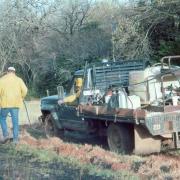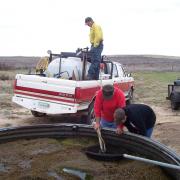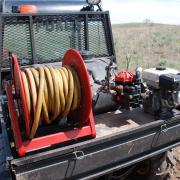There are many kinds and configurations of water pump units. Functionality of the unit is the most important feature to be aware of. When designing a pumper unit, make sure the vehicle supporting the pumper can handle the terrain (preferably four-wheel drive) and is suited for the amount of water the tank will hold. Vehicles with over-sized water tanks for their carrying capacity may struggle to traverse rough terrain. Getting stuck when a fire escapes is the last thing a burn boss needs to worry about.
When deciding on the type of pump, hose, and nozzle, make sure to choose low volume and high pressure components. High volume nozzles are usually reserved for extreme cases in wildland fire. Low volume-high pressure systems allow burners to conserve water in environments where it may be difficult to resupply. The high pressure systems also help to smother the fire in addition to the moisture they deliver to the fire.
Here are some examples of pumper units used on prescribed fires from across the country:







